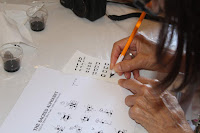“Forever, O Lord, Thy Word is settled in heaven.”
Psalms 119:89
 |
| Yemenite Scribe |
The Hebrew scribe transmits the Torah, which is used
throughout the ages. The materials to make a Torah have not changed either.
A Torah is written in a sweeping motion by a reed or turkey
feather. They are kept in a box with cedar balls (instead of mothballs).
The
sofer (scribe) creates a fountain pen like top with a slit that gives the exact space of
1 kulmus. The delicate balance is very important to the scribe.
A sofer counts,
measures 9 squares, in which e.g. a letter beet must fit. A kosher B has 3
squares, ב
but when he misses a part, the beet becomes a nun
נ . Missing one square,
the shape changes and it becomes a reesh ר . The tsura = shape defines the
characteristics of the Hebrew letter. A
yud is 1 kulmus. The blanc (white) are
of the letter is also important because it defines the letter - black fire
(text) on white fire (parchment).
In order for the ink to flow, the parchment must be in a
room with at least 60% humidity.
A modern scribe can only work 4 hours a day, using an
ergonomic working table, and he must do regular hand exercises. 75 % of those enrolling in the scribal college
do not finish the course.
 The main ingredients for ink acceptable in writing Torah
Scrolls and other articles that have the same standard are: Water, Oak Gall
Nut, Gum Arabic, Soot, Logwood, Copper Sulfate or Iron Sulfate.
The main ingredients for ink acceptable in writing Torah
Scrolls and other articles that have the same standard are: Water, Oak Gall
Nut, Gum Arabic, Soot, Logwood, Copper Sulfate or Iron Sulfate.
Ink used in
writing STaM (Scrolls, Tfillin, Mezuzah) is called D’yo.
The quality of ink is perhaps the main reasons a Scroll could
survive for centuries.
The Isaiah Scroll, found in Qumran is likely to have been copied
by a single scribe.
The text displayed a scribal hand typical of the period of
125-100 BCE.
Klaf – vellum – parchment
In the USA, when a slaughtered cow happened to be pregnant,
the calf was not used for the meat industry and burned. Nowadays, the skin of these unborn calves are
used for parchments and Torah scrolls. 70 unborn calves are needed for one Torah scroll. Each
section (parchment sheet) has 2-3 columns.
When all the writings are finished, these sheets are sown
together with animal sinews. The parchments sheets are not kosher until they
are sown together as a Torah scroll.
When a scribe creates a smudge or ruins a letter, that part
of the scroll must be discarded, as the mistake cannot be carved out. These
parchments are then buried in a genizah.
Certain letters can be expanded to fit a line of
paragraph/column: heh, dalet, reesh, tav and sometimes the lamed . Other letters cannot. E.g. an expanded bet would become a
nun; a waav becomes a reesh and an reesh become a wav.
Tefilim and mezuza text
is not justified.
When a scribe is writing the name of God, even when a ruler
of a nation or other important person would come into his room, he will not
stand up to pay homage until he finishes writing that word. Only in case the
scribe’s life would be in danger if he continues to write, then he must do so.
Not far from their house is the Way of the Patriarchs - Derech haʾAvot - Lit. Way (of) the Fathers). The ancient north south route traversed the land of Israel and frequently travelled by Abraham, Isaac and Jacob.
Today, the route roughly follows the original Highway 60
through the Biblical Heartland.
Roman milestones along the route are proof that in Roman
times the route was used as a major road. The area has seen heavy fighting during the 1948 War of
Independence, was occupied by the Jordanians and only after the 1967 Six Day
war the Jewish people were able to come back and resettle the land.
Efrat has a special history of itself.
Previously called
Efrata, it was established in 1983 and is considered as the capital of Gush
Etzion. Efrat is inhabited by over 10,000 people including both native Israelis
and immigrants from the US, Canada, South Africa, England, Russia and
elsewhere. Approximately 95% are observant or traditional. Efrat's seven
hilltops are named for the biblical seven species grown in the Land of Israel -
Rimon, Te'ena, Gefen, Dekel, Zayit, Dagan, Tamar. Each hilltop is a separate
neighborhood with its own synagogue.
We learned so much this day, about the holiness and the
secrets and wisdom of the Hebrew letters. And there's so much more to glean!
Shmuel dedicated this seminar to the memory of Dvir Sorek,
a 19-year-old Yeshivah student who was a study friend of Shmulik’s son.
Private Sorek studied at a Yeshiva program that allows religious scholars to study and
then to serve together in an army combat unit. Formally enlisted in February,
he was to continue his studies at the yeshiva until basic training in March next
year. Unarmed, in civilian clothing he vanished while returning from a trip to
Jerusalem to buy gifts for his teachers. On the morning of August 8, he was
found with multiple stab wounds between the settlements of Migdal Oz and Efrat.
Militant terrorist groups praised the killing and Hamas called it a “heroic and
courageous act” and urged Palestinians to harbor the perpetrators. When Private
Sorek was an infant, his grandfather Rabbi Binyamin Herling was killed when
Palestinians opened fire on a group of Israelis who were hiking on Mount Ebal,
near Nablus, escorted by a few soldiers.
 |
| Dvir Sorek z"l |
Dvir Sorek – may his memory be a blessing! And may his
family be comforted with those who mourn in Zion.
Oldest Torah scroll:
History of Efrat
























